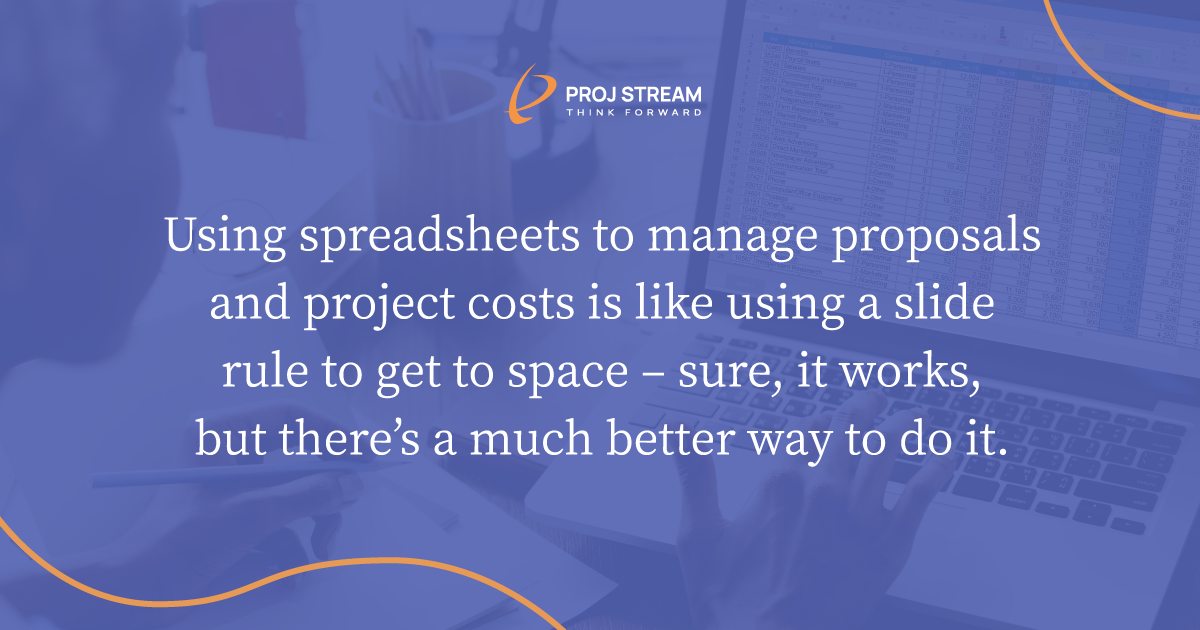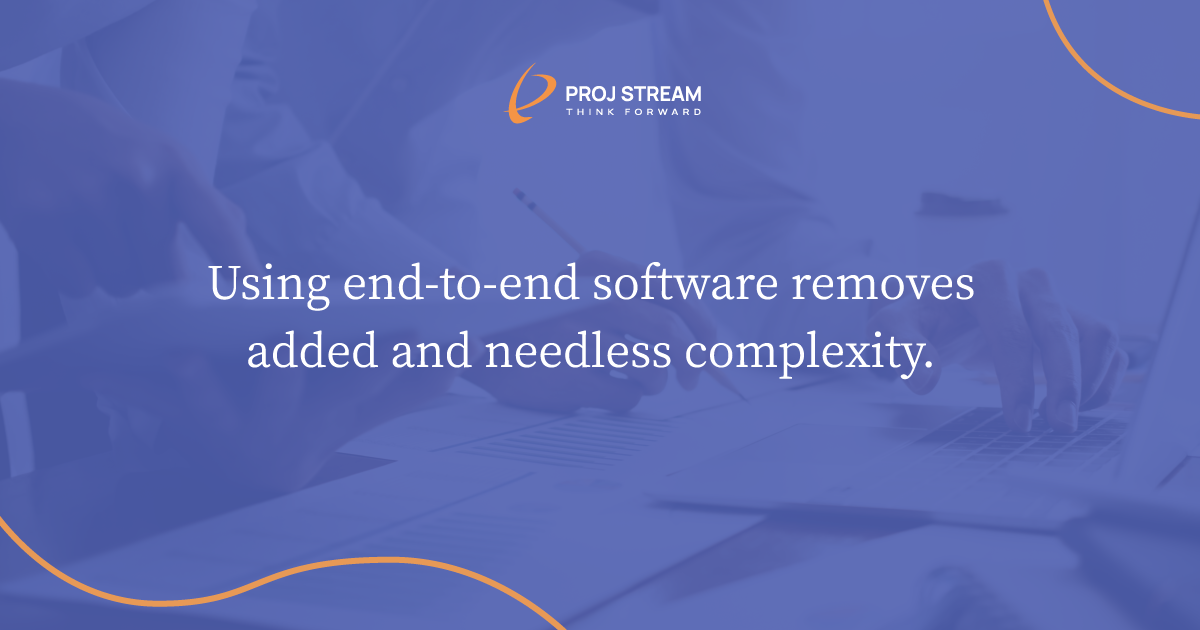You build world-class, cutting-edge technology and products. Your teams are innovating and creating at the forefront of development. Your organization’s success depends on well-crafted, accurate proposals and the ability to execute on them, from the project’s basis of estimate to its final report.
And yet, while creating products that are changing the world, many of the most innovative tech companies are still using spreadsheets to manage project data. Using spreadsheets to manage proposals and project costs is like using a slide rule to get to space – sure, it works, but there have been some serious improvements and if you’re not using them, you’re at a competitive disadvantage.
If you’re still using a process reliant on spreadsheets and a patchwork of in-house and commercial-off-the-shelf systems, and siloed, manually entered data, you’re strangling your innovation and capacity for success. Technological advances shouldn’t be just for your clients – you should benefit from them too.
If a disjointed system is your enemy, an end-to-end solution for proposal and project management can help your organization meet the challenges that today’s market brings with speed, agility, and efficiency.
1. They’re making your process overly heavy and complicated by not giving you a single source of truth.
If your team is managing multiple databases and interfaces and uses macros, plugins, and add-ons for workflow, reporting, and other key activities, it’s a sign that the software technology your teams are using may not be keeping up with the times.
Microsoft Excel, Project, PowerPoint, etc., are useful tools for many things but they’re not best-suited to meet the needs of today’s government RFP process, even when they’re connected to other data products. A cluster of databases, spreadsheets, and programs cannot equal the power or efficiency provided by a single source of truth.
When you submit a proposal, you should feel confident that details related to risks, assumptions, and the financial commitment are solid. If the data is scattered through multiple programs and needs to be compiled manually, it adds risk to your proposal accuracy, and significant time to iterations. A system with a single database design creates massive benefits, from creating more reliable cost estimates to cross-team communication to more efficient proposal iteration.
2. They’re keeping your cost estimates from being realistic.
If this thought makes you feel uncomfortable, you’re not alone. We’ve found over half the government contractors we talk to do not have a standard cost estimating requirements description in place. In fact, one large defense contractor actually had a customer determine that they had an error rate in the basis of estimate justification documentation of 30% on average. (Fortunately, the contractor reduced those errors to less than 2% using ProjStream’s tools.)
It’s understandable. Cost estimates depend on many factors, and when a system is disconnected, gathering those estimates can be a real challenge.
How justifications and basis of estimates are written and formatted add credibility, which in turn can lead to greater profitability. Producing a data-driven basis of estimate provides fact-based information that makes it easier for the customer to evaluate the proposal. Of course, a reliable estimate is not only important to your prospective client. It’s also critical for your organization’s success as well.
For even more solid estimate justification, usr a solution that allows you to leverage close loop cost estimating. This data-driven method produces highly accurate estimates based on historical data, including outcomes of past projects.

3. They can’t provide you with accessible, accurate historical data for more accurate proposals.
Cost estimating is the process of developing the approximate cost of completing a defined scope of work, a quantitative result that can be substantiated. If it’s difficult to access historical data, proposals will be based on assumptions that may not be true or justifiable. This leads to proposals that are less competitive and that won’t win. Or, possibly worse, if the data is of poor quality, or isn’t realistic, even “wins” may cause capacity issues and drive down profitability – the opposite of your goals.
Companies with a strategic goal of using historical data-driven estimates typically improve their win rates by up to 25%. Having historical data on hand increases the accuracy of your proposal and improves the confidence of all teams involved in the process.
Historical data provides other benefits as well, including verifiable estimates, indications of past performance, more accurate staffing profiles, and feeds into a virtuous cycle of data that provides a foundation for informing and improving every project.
4. They’re limiting your pricing strategies.
Your goal is to create a realistic, profitable bid. Pricing is the process of determining the amount of money your company will charge the customer to deliver the product or services as specified in the RFP, which is based on the project estimate.
Sometimes there’s only one path forward, but more often there can be several approaches which represent the same overall outcome with different timelines, costs, or development processes. A winning proposal may require consideration of several different pricing strategies for government contractors.
It’s hard to think strategically about pricing when so much of your focus is on merging ad-hoc Excel spreadsheets filled with estimating and pricing data, basis of estimate supporting documents, bills of material, supplier data, and other details into something cohesive.
But the real challenge comes when you want to explore multiple scenarios to find the most effective strategy.
How easy is it to create pricing and estimating scenarios? Does your data allow you to do a “what-if” analysis or evaluate multiple approaches to pricing? How often are you sure that the pricing you’re submitting makes the best sense?
An effective pricing strategy can’t be created without a solid proposal cost estimation, a quantitative result the proposal team cost estimating professionals can substantiate.
5. They’re killing your response rates for proposal iterations and changes.
Proposals are seldom “one and done” projects. It’s imperative that you be able to turn around changes quickly and beat your competitors to the inbox at every opportunity.
As new information becomes available, your proposal should be able to adapt to meet common challenges like changes to scope or timeframe. Yet, many organizations dread these changes, because tracking changes, or even making them, is so laborious and time consuming. If that’s your reality, you’re not alone.
Evidence shows companies implementing best practices, as well as enterprise global update capabilities, can reduce the time to process proposal iterations by as much as 90% with the right toolset.
A well supported change control process and tools that help manage and track proposal iterations can turn this stage into an advantage. In fact, the most effective proposal teams use their ability to create rapid, accurate iterations to create confidence and showcase their problem-solving acumen, both of which are desirable.

6. They’re boxing in your cross-team communication.
Proposals require educated assumptions, and you often need input from others in engineering, manufacturing, or technology to help ensure the end result is solid. You have to present your assumptions to others, and be able to explain how you came by them. This can be a challenge when you’re pulling from multiple sources, and if it’s discovered that one part is inaccurate, it can become a data avalanche.
That whole story becomes even more critical when passing the project to the project execution team. While spreadsheets may be used for proposal cost estimate and project cost estimates, but –even connected with a patchwork of other programs– they are not good at providing a place for the kinds of details connected to the numbers to exist. Without a data-driven cost estimate, you’re not able to communicate well with other teams, and it will be even harder to communicate with your prospect.
7. They can’t help you judge resource capacity.
Reliance on spreadsheets for project data can limit knowledge continuity between the business capture team and the program execution team, leading to resource issues.
When you submit a proposal, you should feel confident that details related to risks, assumptions, and the financial commitment are solid. You recognize the need to proactively manage the resource demands for your awards, to ensure the right labor resources are available when you need them.
A benefit of a comprehensive system is being able to provide centralized information for resource planning including current demands, queued projects, and resource availability. Resource planning helps a proposal team consider risk factors appropriately and create “what if” scenarios accounting for them. In addition to stronger proposals, a more complete understanding of resource capacity allows everyone involved to provide the project with its best chance for success.
Having complete, accurate data that a project manager can use to plan and secure resources provides solid ground for a successful project. As work moves forward, realtime data can be compared to proposal data to project needs over the life of the project.
When the data gathered and provided is made available as historical data, it will inform the proposal teams when considering future projects, creating a cycle of information that leads to more successful bids and projects.
8. They’re not good for project management, no matter how great the template is.
You may not need a standalone earned value management software to integrate schedule, costs, and scope to measure your project’s performance. But you do need more than a spreadsheet for measuring project performance and progress.
And there’s an Excel template for everything: every section of a project including proposal, budget, timeline, project review, project tracking, and project report – and templates for earned value management, agile project management, and even rolling wave planning scheduling.
“Good enough for government work,” might have been referencing these kinds of templates–you’ve probably experienced at least one of them. You also know the sum of these parts can quickly become more liability than an asset, bound by manual data entry and endless copying and pasting. They’re also not good at communicating and sharing details or providing the kind of information needed to maintain compliance or help see you through an audit. For that, you need to move outside the rows and columns.
A better option is to use a software tool that supports your internal project control process and procedures, like ProjStream’s unique end-to-end solution. Designed to help teams cut down on chaos, these tools can coordinate entire projects from start to finish. Create proposals, budgets, workflows and reports, and manage timelines, budgets, and resources using a single source of data. Scale to provide the right level of oversight and data for every project, making project management best practices available for every project, regardless of size, complexity, or budget.
9. They can’t provide reliable estimates at completion during project execution.
If you’re like some contractors, you may be only tracking revenue and estimates at completion for major projects because it’s such a laborious process that you can’t afford to do it on the smaller ones. This process includes adding cumulative to date actual costs to the estimate to complete to show what the total expenditure will be at the completion of the project.
Not surprisingly, this puts your firm at a major disadvantage, because it becomes difficult to forecast areas of concern, and it endangers the project’s profitability. Being able to manage and access data about the schedule, cost factors, realized or emerging risks, and resource requirements that will affect the project outcome can’t be communicated with a spreadsheet.
This kind of budget maintenance allows a team to make strategic decisions about projects, and it allows you to use best practices with every project, not just the biggest ones.
Flexible software solutions like ProjStream can scale so every project can be appropriately managed and tracked for profitability.
10. They may be playing a key role in making inefficiency part of your corporate culture.
What does your proposal process tell us about your organization? Do your proposals reflect the quality of your products, or do they suffer due to ingrained inefficiencies in your process, project, and data management?
Data managed across sprawling spreadsheets may say more about your organization than you’d think.
Data that needs manual updating, copying and pasting, or requires complicated import and export processes results in duplicated effort in multiple project stages (and is often rife with errors.) Spreadsheets –even connected with a patchwork of other programs– don’t typically have synchronization, meaning that every change can bring proposal creation practically back to the estimation stage. Siloed data may inadvertently encourage siloed teams and reduce your potential for collaboration.
Providing teams with the data and resources they need to do their best work shows a commitment to efficiency and innovation, which we can all agree are values of quality.
Getting Away From Spreadsheets
You’re pitching prospective clients “the right tools” with every proposal you write, sharing how those tools will meet their needs and goals. It’s only fair that you get to use the right tools to meet your project’s needs too: not a point solution, or just estimating, or just project management.
An end-to-end solution can help your team confidently create data driven cost estimates, use them to create the budget baseline after contract award, easily transition to the execution phase, and manage baseline changes. You’ll also improve collaboration and provide data that will contribute to better project outcomes and a higher proposal win rate.
Even if you’re relatively happy with your existing process, ProjStream will make it better.
Using end-to-end software removes added and needless complexity: no need to write macros, transfer data between tools with different databases and user interfaces, or purchase a suite of add-ons for workflow functions, reporting, and producing electronic deliverables.
And while there will probably always be a spreadsheet, they’ll be on your terms.



